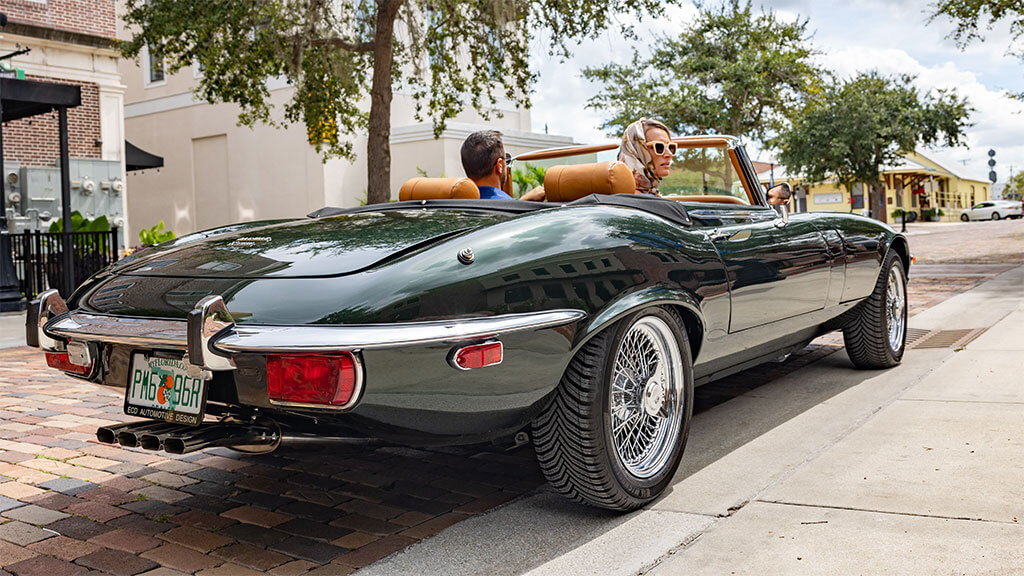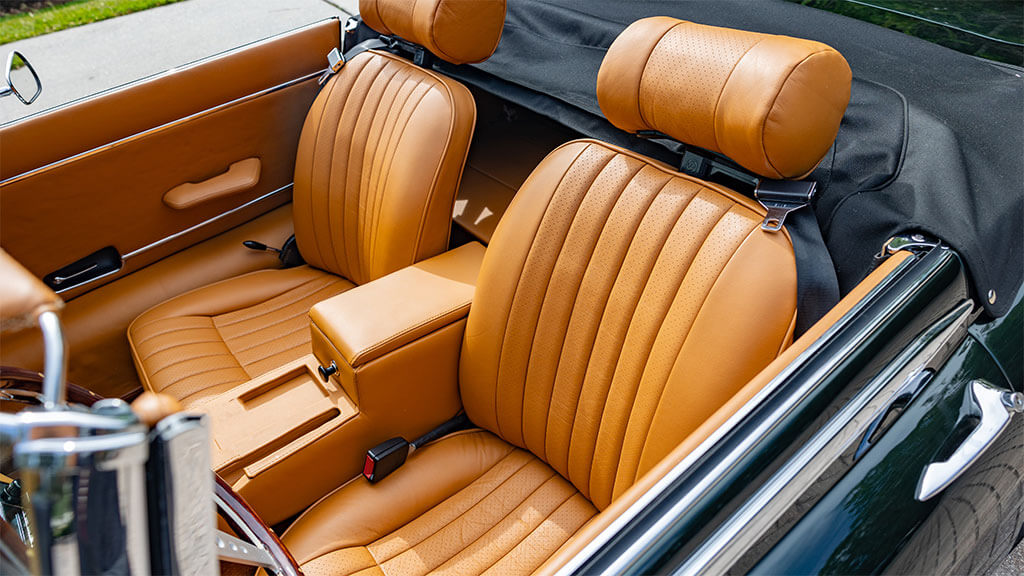Step into the world of automotive restoration as we take you on a journey through the meticulous process of restoring the iconic Jaguar E-Type. With a legendary status and a rich heritage, the Jaguar E-Type holds a special place in the hearts of automobile enthusiasts. From its sleek design to its powerful performance, every aspect of this classic vehicle is a testament to engineering excellence.
In this article, we delve into the restoration process of the Jaguar E-Type, exploring the intricate steps involved in bringing these iconic machines back to their former glory. From disassembly to paintwork, from interior refurbishment to mechanical upgrades, every stage requires a skilled and dedicated team to ensure utmost authenticity and attention to detail.

Whether you're a vintage car enthusiast, an owner looking to restore your own Jaguar E-Type, or simply a curious soul wanting to learn about automotive craftsmanship, this article will provide you with a comprehensive understanding of the restoration process. So buckle up and get ready to dive into the fascinating world of Jaguar E-Type restoration.
The Jaguar E-Type, also known as the Jaguar XK-E in North America, is a legendary British sports car that captivated the automotive world from its debut in 1961 until the end of its production in 1974. With its stunning aesthetics, exceptional performance, and competitive pricing, the E-Type quickly became an icon of the motoring industry. In fact, it was even hailed as "the most beautiful car ever made" by none other than Enzo Ferrari himself.
The Birth of a Legend Jaguar E-Type
The roots of the Jaguar E-Type can be traced back to the success of the Jaguar D-Type racing car, which dominated the 24 Hours of Le Mans for three consecutive years starting in 1955. Inspired by the D-Type's achievements, Jaguar's racing department set out to create a road-going sports car that would continue the legacy of its racing predecessor.
E1A Prototype: A Glimpse of the Future
In 1957, Jaguar unveiled the E1A prototype, which showcased several groundbreaking features. Designed by William Heynes, Jaguar's Technical Director and Chief Engineer, the E1A featured a monocoque design, independent rear suspension, and the renowned XK engine. Although the E1A was never released to the public and was ultimately scrapped, it laid the foundation for the future development of the Jaguar E-Type.
E2A Concept: Racing Pedigree
Jaguar's second E-Type concept, the E2A, was constructed with a steel chassis and an aluminum body. This racing-oriented car utilized a 3-liter version of the XK engine and was initially used for racing purposes by Jaguar privateer Briggs Cunningham. After its racing career, the E2A returned to Jaguar for testing and eventually ended up in the hands of Roger Woodley, Jaguar's customer competition car manager. In 2008, the E2A was sold at auction for a staggering $4,957,000.
The Series 1: A Timeless Classic
The first production models of the Jaguar E-Type, known as the Series 1, were introduced in 1961. These models were available in two-seater coupe (FHC) and convertible (OTS) versions, both exuding elegance and sophistication. The Series 1 cars can be further divided into two categories based on their production years.
Early Series 1 (1961-1964): Classic Beauty
The early Series 1 E-Types, produced from 1961 to 1964, were equipped with 3.8-liter engines and partial synchromesh transmissions. These cars boasted a lightweight construction, weighing only 1,315 kg (2,899 lb). With their sleek design and remarkable performance, they quickly captured the hearts of car enthusiasts worldwide.
Later Series 1 (1965-1967): Enhanced Performance
From 1965 to 1967, the Series 1 E-Types underwent some significant updates. The engine size was increased to 4.2 liters, providing a boost in both power and torque. Other improvements included reclining seats, an alternator, a negative earth electrical system, and a more reliable brake servo. Despite these enhancements, the timeless beauty of the E-Type's design remained unchanged.
Series 2 and 3: Adapting to Regulations
As safety and emissions regulations evolved, Jaguar introduced the Series 2 and Series 3 E-Types to comply with the new standards, particularly in the North American market. These models featured larger grilles, wider wheel arches, and bigger bumpers to meet the safety requirements. Additionally, they came equipped with a larger radiator and cooling system to address the overheating issues that plagued the earlier Series 1 models.
The Jaguar Legacy Lives On
The Jaguar E-Type's impact extends far beyond its years of production. Its iconic design has been celebrated in various forms of media, including the Diabolik comic series, the Austin Powers films, and the television series Mad Men. In the world of art, the New York City Museum of Modern Art recognized the E-Type's significance by including a blue roadster in its permanent design collection.

The E-Type Concept Zero: A Modern Revival
In 2017, Jaguar unveiled the E-Type Concept Zero, a modern interpretation of the 1968 E-Type Series 1.5 roadster. This electrified version of the classic car featured a 40 kWh battery-powered electric motor that could accelerate from 0 to 60 mph in just 5.5 seconds. With a range of 168 miles on a full charge, the E-Type Concept Zero combined the timeless beauty of the original with the latest advancements in electric powertrain technology.
The Journey Continues: Jaguar E-Type Restoration
For enthusiasts who wish to own and restore a Jaguar E-Type, ECD Auto Design offers a comprehensive restoration service. With their expertise and commitment to craftsmanship, ECD Auto Design can bring these timeless classics back to their former glory. Whether it's a Series 1 or a later model, ECD Auto Design has the knowledge and skills to ensure that every detail is meticulously restored.
Why restore a Jaguar E-Type?
Restoring a Jaguar E-Type is not just about bringing a vintage car back to life; it's about preserving a piece of history. These iconic vehicles have a timeless appeal that transcends generations. Restoring a Jaguar E-Type allows you to experience the thrill of driving a classic car while showcasing the craftsmanship of a bygone era.

The importance of proper planning and research
Before embarking on a Jaguar E-Type restoration project, it is crucial to develop a solid plan and conduct thorough research. Understanding the vehicle's history, identifying the original specifications, and gathering the necessary resources will ensure a successful restoration journey.
Assessing the condition of the vehicle
When restoring a Jaguar E-Type, the first step is to assess the condition of the vehicle. This involves a detailed inspection of the bodywork, engine, interior, electrical system, and suspension. By identifying areas that require repair or replacement, you can create a comprehensive restoration plan.
Restoring the bodywork
The bodywork of a Jaguar E-Type is a work of art, and restoring it to its former glory is a labor-intensive process. This involves stripping the car down to the bare metal, repairing any rust or damage, and meticulously applying multiple layers of primer and paint. Attention to detail is crucial to ensure a flawless finish.
Engine restoration and upgrades
The heart of any vehicle is its engine, and the Jaguar E-Type is no exception. Restoring the engine involves disassembling and inspecting each component, repairing or replacing worn parts, and reassembling with precision. Upgrades such as improved cooling systems or electronic fuel injection can enhance the performance and reliability of the engine.
Interior restoration and customization
The interior of a Jaguar E-Type showcases the luxurious craftsmanship of the era. Restoring the interior involves reupholstering seats, replacing carpets, and refurbishing the dashboard and trim. For those seeking a personalized touch, customization options such as modern audio systems or bespoke upholstery can be incorporated.
Electrical system and wiring restoration
The electrical system of a vintage car like the Jaguar E-Type often requires attention due to age-related issues. Restoring the electrical system involves inspecting and repairing or replacing wiring, switches, and electrical components to ensure proper functionality and safety.
Suspension and brake system upgrades
To enhance the driving experience and improve safety, upgrading the suspension and brake systems is essential. This may involve replacing worn-out components with modern alternatives or incorporating specialized upgrades for improved handling and performance.
Paintwork and final touches
The paintwork of a Jaguar E-Type is a crucial aspect of the restoration process. Applying the correct color and finish requires meticulous attention to detail. Once the paintwork is complete, final touches such as chrome trim, badges, and emblems are added to complete the authentic look of the restored vehicle.
Cost considerations and budgeting
Restoring a Jaguar E-Type is a labor of love, but it also comes with financial considerations. Setting a realistic budget and carefully planning expenses for parts, labor, and unforeseen challenges is essential to avoid any financial surprises along the way.
Finding a reputable restoration shop
Restoring a Jaguar E-Type requires expertise and specialized knowledge. Finding a reputable restoration shop with experience working on these classic vehicles is crucial. Seek recommendations, review portfolios, and visit restoration facilities to ensure you entrust your vehicle to skilled professionals.
Frequently asked questions about Jaguar E-Type restoration
1. How long does it take to restore a Jaguar E-Type? The time required for restoration can vary depending on the condition of the vehicle and the extent of the restoration. On average, a complete restoration can take anywhere from several months to a year or more.
2. Can I restore a Jaguar E-Type myself? While it is possible to restore a Jaguar E-Type yourself, it requires a high level of skill, knowledge, and access to specialized tools and equipment. It is advisable to seek professional assistance or join a restoration workshop if you are not experienced in automotive restoration.
3. How much does it cost to restore a Jaguar E-Type? The cost of restoring a Jaguar E-Type can vary significantly depending on the condition of the vehicle and the desired level of restoration. A complete restoration can range from tens of thousands to hundreds of thousands of dollars.
4. Are original parts available for Jaguar E-Type restoration? Yes, original parts for Jaguar E-Type restoration are available through various suppliers and salvage yards specializing in vintage car parts. However, due to the limited availability of some parts, sourcing and acquiring them may require time and effort.
Conclusion
The Jaguar E-Type holds a special place in automotive history as an icon of beauty and performance. From its early prototypes to the final production models, the E-Type exemplified Jaguar's commitment to elegance and engineering excellence. Whether it's the Series 1's classic charm or the later models' adaptability, the legacy of the E-Type continues to captivate car enthusiasts and collectors around the world.


